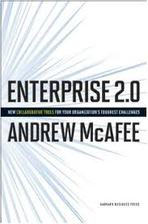|
At the recommendation of a friend, I read Enterprise 2.0: New Collaborative Tools for Your Organization's Toughest Challenges by Andrew McAfee. As someone deep in technology, I had already been a regular user and fan of many of the technologies presented in the book. I found it helpful hearing stories, though, of many small and large companies grapple with incorporating new IT tools into their workflows and hearing some theory around why certain things worked better than others.
The book presented an overview and description of several new technologies, focusing on the similarities among them and how companies have been applying them to be more successful. The author was originally a skeptic of the term "Web 2.0" but through research and direct case studies realized there was much value in the new technologies and a clear shift in how people were working because of them. The author got so deep into them that he was the original person who coined the term "Enterprise 2.0" and went on to write many articles for general managers to learn how to incorporate these tools. Part 1: The Power of Collaborative Technology in Business This part first went through four case studies and presented the "problem" they were facing (solution described later). 1. VistaPrint As VistaPrint's team grew rapidly, their engineering team need a way to bring new hires up to speed quickly, and so they desperately needed a thorough knowledge base. 2. Serena Software Serena had a majority of its workforce telecommuting, and it was struggling in unifying its team and meeting aggressive goals that required cohesive team effort and creativity, all while operating from a distance. 3. 9/11 Commission The Commission found that the biggest reason for failing to thwart the 9/11 attacks was the lack of information sharing across agencies. A new initiative driven by technology and more guided sharing won the intelligence community's Galileo Award and promises to help in this regard in the future. 4. Google An engineer at Google was inspired by the book The Wisdom of Crowds and various electronic prediction markets like Iowa's Markets and the Hollywood Stock Exchange. These exchanges that aggregated many opinions were found to be more accurate than experts. This engineer created an internal betting system within Google that ended up producing internal product and engineering forecasts even more accurate than those of its senior staff. Computer Supported Collaborative Software (CSCW) In the beginning, there were two fairly unpopular approaches to collaborative software. The first was groupware, mainly in the form of Lotus Notes, and the second was over-generalized knowledge management systems, which aimed to create highly structured and overly controlled databases of knowledge. Then came Web 2.0. The key to success of the new wave of technologies was network effects. The platforms were free and easy, and the structure was not defined in advance. This was evident in the Nupedia to Wikipedia transition, Yahoo's initial classification/taxonomy going away, and the advent of Delicious's freeform tagging model. The concept these systems used was to let structure emerge naturally, like Google's PageRank algorithm and tag cloud "Folksonomies" (taxonomies generated by folks). These used the concept called "emergence" as defined by research that studied swarm intelligence and ant colony substructure. The key to success of any such system is to have some adequate minimal set of rules and provide fast, full feedback to users. This is what allows these new systems, called "emergent social software platforms" (ESSPs) to grow. Other characteristics of CSCWs are that they're optional (not imposed on people) and inherently free of imposed structure. They feel egalitarian and are accepting of different types of data. The key capabilities in the systems are search, links, authoring, tags, extensions/smart recommendations/suggestions, and signals for new content. Enterprise 2.0, thus, is defined as the use of emergent social software in organizations in pursuit of their goals. New approaches to old problems
Part 2: Succeeding with Enterprise 2.0 Red Herring Concerns
0 Comments
Your comment will be posted after it is approved.
Leave a Reply. |
Archives
June 2024
Categories
All
Subscribe |

 RSS Feed
RSS Feed
